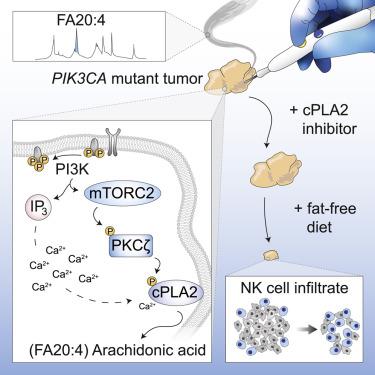Cell ( IF 45.5 ) Pub Date : 2020-06-18 , DOI: 10.1016/j.cell.2020.05.053 Nikos Koundouros 1 , Evdoxia Karali 2 , Aurelien Tripp 2 , Adamo Valle 3 , Paolo Inglese 4 , Nicholas J S Perry 2 , David J Magee 5 , Sara Anjomani Virmouni 6 , George A Elder 7 , Adam L Tyson 8 , Maria Luisa Dória 4 , Antoinette van Weverwijk 9 , Renata F Soares 4 , Clare M Isacke 10 , Jeremy K Nicholson 11 , Robert C Glen 12 , Zoltan Takats 4 , George Poulogiannis 1

|
Oncogenic transformation is associated with profound changes in cellular metabolism, but whether tracking these can improve disease stratification or influence therapy decision-making is largely unknown. Using the iKnife to sample the aerosol of cauterized specimens, we demonstrate a new mode of real-time diagnosis, coupling metabolic phenotype to mutant PIK3CA genotype. Oncogenic PIK3CA results in an increase in arachidonic acid and a concomitant overproduction of eicosanoids, acting to promote cell proliferation beyond a cell-autonomous manner. Mechanistically, mutant PIK3CA drives a multimodal signaling network involving mTORC2-PKCζ-mediated activation of the calcium-dependent phospholipase A2 (cPLA2). Notably, inhibiting cPLA2 synergizes with fatty acid-free diet to restore immunogenicity and selectively reduce mutant PIK3CA-induced tumorigenicity. Besides highlighting the potential for metabolic phenotyping in stratified medicine, this study reveals an important role for activated PI3K signaling in regulating arachidonic acid metabolism, uncovering a targetable metabolic vulnerability that largely depends on dietary fat restriction.
Video Abstract
Download : Download video (18MB)
中文翻译:

代谢指纹图谱将致癌 PIK3CA 与增强型花生四烯酸衍生的类二十烷酸联系起来。
致癌转化与细胞代谢的深刻变化相关,但追踪这些变化是否可以改善疾病分层或影响治疗决策尚不清楚。使用 iKnife 对烧灼标本的气溶胶进行采样,我们展示了一种新的实时诊断模式,将代谢表型与突变PIK3CA基因型耦合。致癌性PIK3CA导致花生四烯酸增加,并伴随类二十烷酸过量产生,从而促进细胞增殖,超出细胞自主方式。从机制上讲,突变型PIK3CA驱动多模式信号网络,涉及 mTORC2-PKC z 介导的钙依赖性磷脂酶 A2 (cPLA2) 激活。值得注意的是,抑制 cPLA2 与无脂肪酸饮食协同作用,可恢复免疫原性并选择性减少突变PIK3CA诱导的致瘤性。除了强调分层医学中代谢表型分析的潜力外,这项研究还揭示了激活的 PI3K 信号在调节花生四烯酸代谢中的重要作用,揭示了很大程度上取决于饮食脂肪限制的可靶向代谢脆弱性。
视频摘要
下载:下载视频 (18MB)











































 京公网安备 11010802027423号
京公网安备 11010802027423号